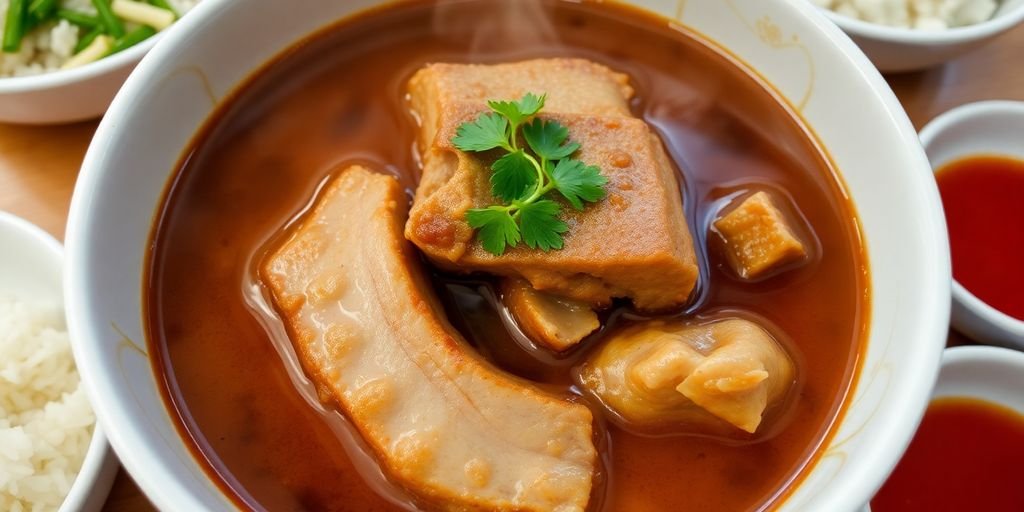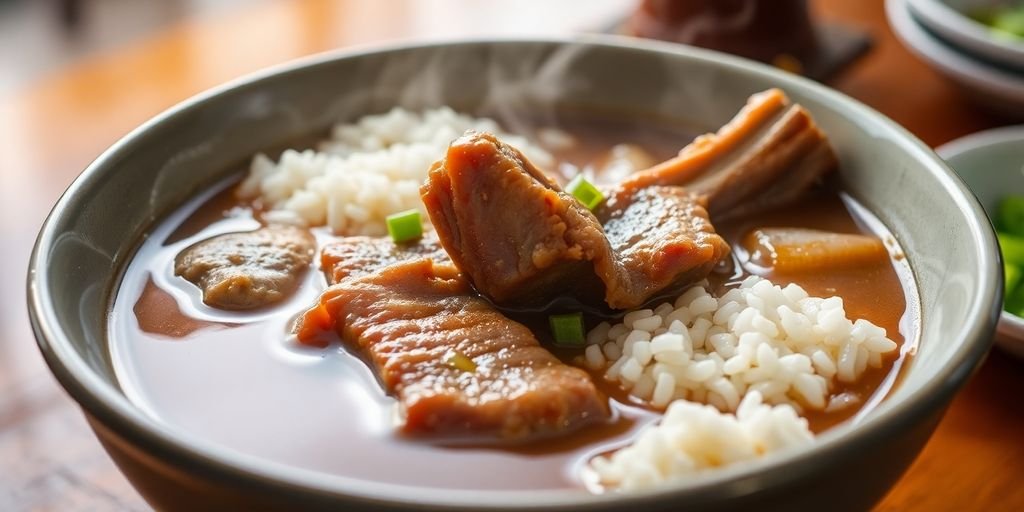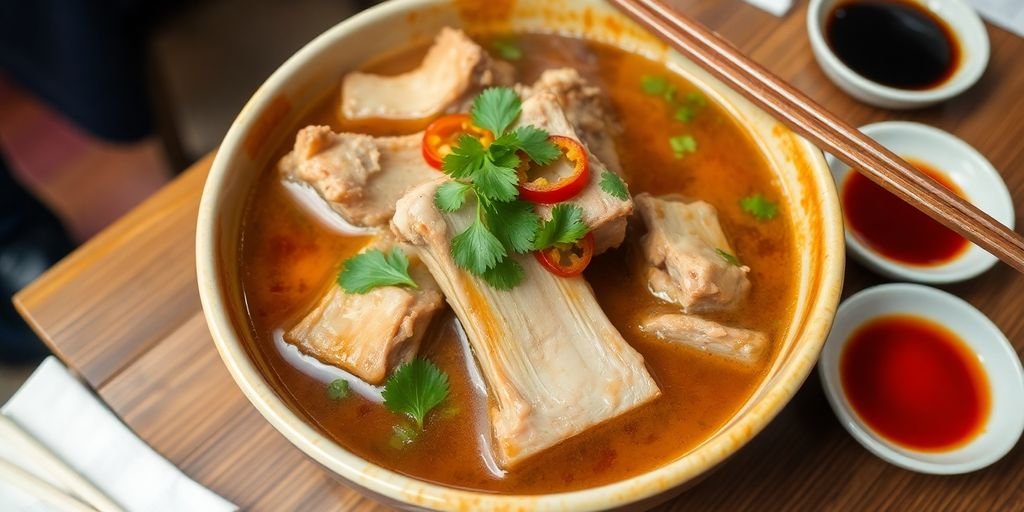Bak Kut Teh is more than just a dish; it’s a comforting bowl of history and flavor that has become a staple in Singapore’s food scene. Translating to “meat bone tea,” this delicious pork rib soup is rich in both taste and cultural significance. Whether you’re a local or a visitor, enjoying Bak Kut Teh is a must-do experience that showcases the heart of Singaporean cuisine. Let’s take a closer look at what makes this dish so special.
Key Takeaways
- Bak Kut Teh translates to ‘meat bone tea’ and is a beloved pork rib soup in Singapore.
- The dish has roots in Chinese culinary traditions, particularly from the Hokkien and Teochew communities.
- There are various styles of Bak Kut Teh, including Teochew and Hokkien versions, each with unique flavors.
- Preparing Bak Kut Teh involves simmering pork ribs with a mix of herbs and spices, creating a rich broth.
- Some of the best places to enjoy Bak Kut Teh in Singapore include iconic restaurants and hidden gems known for their unique recipes.
Understanding Bak Kut Teh

Origins of Bak Kut Teh
So, where did this comforting dish actually come from? Well, the story goes that Bak Kut Teh started way back in the 19th century in the Fujian province of China. As Chinese folks moved around, the Hokkiens and Teochews brought their food traditions, including this one, to places like Malaysia and Singapore. Over time, it’s become a real icon of Southeast Asian cooking. It’s more than just a meal; it shows off the region’s diverse food scene. Some folks even say it might be based on a Quanzhou dish with beef ribs and herbs. Pretty cool, huh?
Cultural Significance
Bak Kut Teh isn’t just food; it’s a whole experience wrapped up in a bowl. It represents the blending of cultures and the resourcefulness of early immigrants. Think about it: a hearty, affordable meal that provided energy for laborers. It’s become a symbol of community, often enjoyed in bustling eateries where families and friends gather. It’s a taste of history, a connection to the past, and a celebration of culinary traditions all in one.
The Evolution of the Dish
Bak Kut Teh has changed quite a bit over the years. What started as a simple, nourishing meal has become something much more complex. Different regions have put their own spin on it, leading to the various styles we see today. From the clear, peppery broth of Teochew-style to the dark, herbal Hokkien version, each variation tells a story. Even the ingredients have evolved, with some places adding premium cuts of pork or extra herbs for a more intense flavor. It’s a dish that keeps adapting, while still holding onto its roots.
Bak Kut Teh’s journey from a humble street food to a celebrated national dish is a testament to its enduring appeal and adaptability. It reflects the changing tastes and preferences of the people, while still retaining the essence of its original purpose: to provide a nourishing and satisfying meal.
The Unique Flavors of Bak Kut Teh
Herbal Infusions
Bak Kut Teh isn’t just pork rib soup; it’s a carefully constructed flavor profile built on herbal infusions. The specific herbs used vary, but common ingredients include dong quai, ginseng, star anise, cinnamon, and cloves. These aren’t just for flavor; many are believed to have medicinal properties, contributing to the dish’s reputation as a restorative tonic. The simmering process is key, allowing the herbs to fully release their essence into the broth. It’s a delicate balance – too much of one herb can throw off the entire flavor profile.
Broth Characteristics
The broth is the heart and soul of Bak Kut Teh. Its characteristics depend heavily on the style of preparation. Some broths are light and peppery, while others are dark and intensely herbal. The cooking time also plays a significant role; a longer simmer results in a richer, more concentrated flavor. The broth should be clear, not cloudy, indicating a well-executed cooking process. It’s often served piping hot, encouraging you to savor the aromas and flavors.
Key Ingredients
While the herbs define the flavor, the pork ribs are the star. The cut of pork used significantly impacts the final result. Meaty ribs are preferred, offering a good balance of meat and bone. Garlic is another essential ingredient, often added whole to the broth for a subtle, pungent flavor. Other common additions include white pepper, soy sauce (light and dark), and sometimes dried mushrooms. These ingredients work together to create a complex and satisfying flavor profile. The pork belly is also a key ingredient.
The beauty of Bak Kut Teh lies in its simplicity. It’s a dish built on a few key ingredients, but the way those ingredients are combined and cooked makes all the difference. It’s a testament to the power of simple, honest cooking.

Here’s a breakdown of common ingredients and their roles:
- Pork Ribs: Provide the meaty base and richness.
- Garlic: Adds pungency and depth of flavor.
- White Pepper: Contributes a subtle heat and aroma.
- Soy Sauce: Enhances the savory notes and adds color.
Variations of Bak Kut Teh
Bak Kut Teh isn’t just one thing; it’s a whole family of flavors! The basic idea is pork ribs in a flavorful broth, but the specific herbs, spices, and cooking methods can change a lot depending on who’s making it and where they’re from. Let’s check out some of the most popular variations you’ll find.
Teochew-Style Bak Kut Teh
This style is known for its clear, peppery broth. It’s lighter in color compared to other versions, and the focus is on the clean taste of pepper and garlic. You’ll still get the herbal notes, but they’re more subtle. It’s a great choice if you prefer a less intense, more refreshing bowl of peppery soup.
Hokkien-Style Bak Kut Teh
If you like a richer, darker flavor, Hokkien-style Bak Kut Teh is the way to go. Soy sauce is a key ingredient here, giving the broth a deeper color and a savory taste. You’ll also find a more robust blend of herbs, creating a more complex and intense flavor profile. It’s definitely a heartier option for those who want a bolder experience.
Premium and Herbal Versions
Beyond the regional styles, you’ll also find variations that focus on specific ingredients or preparations. Some restaurants offer “premium” Bak Kut Teh, using higher-quality cuts of pork, like prime ribs, and a more elaborate blend of herbs and spices. Then there’s the herbal version, which really emphasizes the medicinal properties of Chinese herbs. The medicinal herbs give the broth a stronger, more distinct flavor, almost like a tonic.
It’s worth noting that even within these categories, there can be a lot of variation. Every cook has their own secret recipe and tweaks the ingredients to their liking. That’s part of what makes exploring Bak Kut Teh so interesting – you never know exactly what you’re going to get, but it’s almost always delicious.
How to Prepare Bak Kut Teh
Essential Ingredients
Okay, so you wanna make Bak Kut Teh at home? First, you’re gonna need the right stuff. It’s not too complicated, but getting good quality ingredients makes a huge difference. Here’s a basic list:
- Pork ribs (about 1 kg, cut into pieces)
- Garlic (a whole head, unpeeled – trust me!)
- Bak Kut Teh spice mix (you can find these at most Asian grocery stores)
- Light and dark soy sauce
- White pepper
- Salt
Some people also like to add dried shiitake mushrooms or tofu puffs, but that’s totally up to you. Don’t skimp on the garlic though; that’s key. You can find a good spice mix at your local Asian market.
Cooking Techniques
Alright, now for the fun part – cooking! Here’s how I usually do it:
- Blanch the ribs: Boil the pork ribs in water for about 5-10 minutes to get rid of any impurities. Then, rinse them off.
- Sauté the garlic: In a big pot, toss in the whole head of garlic (unpeeled!) and sauté it for a bit until it smells amazing.
- Add the spice mix: Pour in the Bak Kut Teh spice mix and stir it around with the garlic. Let it cook for a minute or two to release the flavors.
- Simmer, simmer, simmer: Add the pork ribs and enough water to cover everything. Bring it to a boil, then lower the heat and let it simmer for at least 1.5 to 2 hours. The longer, the better!
- Season to taste: Add soy sauce, white pepper, and salt to your liking. Remember, the broth should be peppery and flavorful.
The key to great Bak Kut Teh is patience. Don’t rush the simmering process. The longer it simmers, the more tender the ribs will be and the more flavorful the broth will become.
Serving Suggestions
So, you’ve got your Bak Kut Teh ready. Now what? Here’s how I like to serve it:
- With steamed rice: This is a must! The rice soaks up all that delicious broth.
- Youtiao (Chinese fried dough): Perfect for dipping in the soup.
- Soy sauce with chili padi: For an extra kick.
- A pot of strong tea: To cleanse the palate.
Don’t forget to ladle the broth generously over the rice. And remember, Bak Kut Teh is best enjoyed hot! It’s a comforting and satisfying meal, perfect for a chilly day or any time you’re craving something flavorful. Enjoy your homemade Bak Kut Teh!
Best Places to Enjoy Bak Kut Teh

Iconic Restaurants
When you’re on the hunt for stellar Bak Kut Teh, starting with the iconic spots is a must. These restaurants have stood the test of time, often serving up the same delicious recipe for decades. Think of places like Song Fa Bak Kut Teh, a Chinatown institution since 1969. They’re known for their peppery broth that just hits the spot. Or Ng Ah Sio Bak Kut Teh, near Tiong Bahru Market, where the recipe has been passed down through generations. These aren’t just meals; they’re experiences steeped in history.
Hidden Gems
Sometimes, the best Bak Kut Teh isn’t found in the guidebooks, but tucked away in some unassuming corner. These hidden gems are where locals swear by the authentic flavors and unpretentious atmosphere. Friends Bak Kut Teh, located in Bukit Batok, is one such place. It’s got a strong following for its unique blend of herbs and spices, and the warm vibe makes it a real favorite. Finding these spots is like discovering a secret, a culinary treasure that makes the search worthwhile. You might need to ask around, but trust me, it’s worth the effort to find these local favorites.
Local Favorites
What makes a Bak Kut Teh place a local favorite? It’s more than just the taste; it’s the whole package. It’s the consistency, the friendly service, and that feeling of home. Legendary Bak Kut Teh on South Bridge Road is a prime example. They’re committed to quality ingredients and meticulous preparation, which has earned them a loyal following. These are the places where you’ll see families gathering, friends catching up, and everyone slurping down that delicious broth with gusto. It’s a testament to the dish’s ability to bring people together. Here’s a quick rundown of why these spots are so beloved:
- Consistent quality
- Friendly service
- A welcoming atmosphere
These local favorites often have a unique story, a family history, or a special ingredient that sets them apart. They’re not just serving food; they’re sharing a piece of their culture and heritage.
And if you’re looking for something a bit different, don’t forget to check out the premium and herbal versions. Some places offer premium bak kut teh with high-quality ingredients, while others focus on herbal infusions for a more medicinal flavor.
The Experience of Eating Bak Kut Teh

Traditional Accompaniments
Eating Bak Kut Teh isn’t just about the soup; it’s about the whole experience, and that includes what you eat with it. The most common side is definitely youtiao, those long, golden-brown fried dough sticks. Dipping them into the broth is a must. The youtiao soaks up all that flavorful goodness. Besides youtiao, you’ll often find:
- Steamed white rice: A simple but essential base to soak up the broth.
- Braised peanuts: A savory and slightly sweet addition.
- Preserved vegetables: Adds a tangy and crunchy contrast.
Don’t forget the dark soy sauce with chili padi (bird’s eye chili). It’s the perfect dipping sauce for the pork ribs, adding a kick of heat and umami.
Dining Atmosphere
The atmosphere where you eat Bak Kut Teh can really change the experience. You can find it everywhere, from fancy restaurants to hawker centers. Each place has its own vibe. Some iconic restaurants, like Song Fa Bak Kut Teh, have been around for decades, offering a nostalgic feel. Hawker centers are more casual and bustling, perfect for a quick and affordable meal. The clatter of dishes, the chatter of diners, and the aroma of herbs all add to the experience. It’s a sensory overload in the best way possible.
Culinary Rituals
There’s a certain way people enjoy Bak Kut Teh, almost like a ritual. First, you take a sip of the broth to appreciate the complex flavors. Then, you dip the youtiao and savor the combination of textures. Next, you tackle the pork ribs, dipping them in the dark soy sauce. Some people like to add a spoonful of rice to the broth, creating a porridge-like consistency. And of course, you can’t forget the tea. Oolong or Tieguanyin tea is often served to cleanse the palate and aid digestion. It’s all about taking your time and enjoying each element of this Malaysian cuisine.
Bak Kut Teh in Popular Culture

Media Representations
Bak Kut Teh has definitely made its way into popular media. You see it popping up in food shows, travel vlogs, and even dramas that are set in Singapore or Malaysia. It’s often used to represent the local culture and authentic food scene. The way it’s presented can really make you want to try it, showing the steaming broth and tender pork ribs. It’s not just about the food; it’s about the whole experience. It’s a way to explore global BBQ traditions through media.
Celebrity Endorsements
When a celebrity says they love something, people pay attention. There have been instances where local celebrities or even international foodies have raved about their favorite Bak Kut Teh spots. This kind of endorsement can really boost a restaurant’s popularity and draw in crowds. It’s like a stamp of approval that makes people more willing to give it a try. It’s interesting how much influence these endorsements can have on the food scene.
Culinary Competitions
Food competitions are a big deal, and Bak Kut Teh is no exception. You’ll find contests where chefs try to create the best version of the dish, judged on flavor, presentation, and authenticity. These competitions not only showcase the skill of the chefs but also help to highlight the unique flavors of Bak Kut Teh. It’s a fun way to see different interpretations of a classic dish and maybe even discover a new favorite.
It’s interesting to see how a dish with humble origins has become such a cultural icon. From being featured in media to celebrity endorsements and culinary competitions, Bak Kut Teh has really made its mark. It’s a testament to its deliciousness and cultural significance.
Final Thoughts on Bak Kut Teh
In the end, Bak Kut Teh is more than just a dish; it’s a warm hug in a bowl. Whether you’re a local or just visiting, this pork rib soup is a must-try. It tells a story of culture, history, and community. From the rich flavors to the comforting aroma, every spoonful brings a piece of Singapore’s heart to your table. So, next time you’re in Singapore, make sure to seek out this delightful dish. You won’t regret it, and who knows? You might just find your new favorite comfort food.
Frequently Asked Questions
What is Bak Kut Teh?
Bak Kut Teh is a popular dish in Singapore, known as ‘meat bone tea’ in Hokkien. It features tender pork ribs cooked in a flavorful broth made with various herbs and spices.
Where did Bak Kut Teh come from?
The dish originated from southern China, particularly the Fujian province, and was brought to Singapore by Chinese immigrants, especially the Hokkien and Teochew communities.
What are the different styles of Bak Kut Teh?
There are mainly two styles: Teochew-style, which is lighter and peppery, and Hokkien-style, which is richer and darker, often with a complex mix of herbs.
How is Bak Kut Teh traditionally served?
Bak Kut Teh is typically served with steamed rice, youtiao (Chinese fried dough), and sometimes accompanied by pickled vegetables.
Can I make Bak Kut Teh at home?
Yes, you can! To make Bak Kut Teh at home, you’ll need pork ribs, a Bak Kut Teh spice mix, garlic, and water. Simmer the ingredients together for a few hours to get the best flavor.
Where can I find the best Bak Kut Teh in Singapore?
Some of the best places to enjoy Bak Kut Teh in Singapore include Song Fa Bak Kut Teh, Founder Bak Kut Teh, and Ng Ah Sio Bak Kut Teh, each offering their unique take on this delicious dish.


